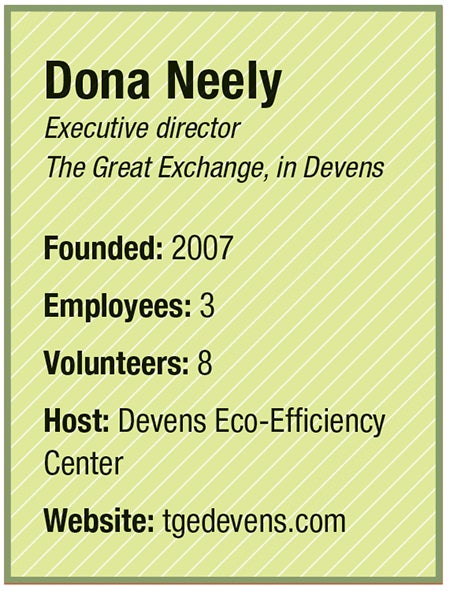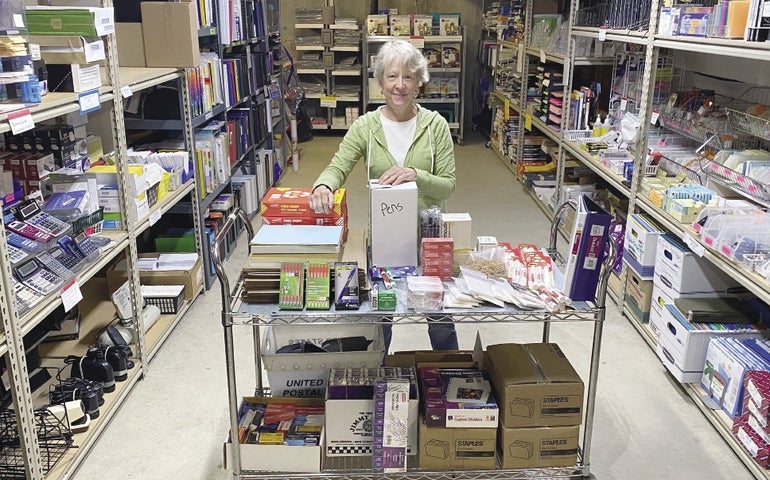The Devens Eco-Efficiency Center is a nonprofit providing programs to help companies make more efficient choices, such as by creating The Great Exchange, a marketplace for the reuse of materials destined for the trash.
Get Instant Access to This Article
Subscribe to Worcester Business Journal and get immediate access to all of our subscriber-only content and much more.
- Critical Central Massachusetts business news updated daily.
- Immediate access to all subscriber-only content on our website.
- Bi-weekly print or digital editions of our award-winning publication.
- Special bonus issues like the WBJ Book of Lists.
- Exclusive ticket prize draws for our in-person events.
Click here to purchase a paywall bypass link for this article.
The Devens Eco-Efficiency Center is a nonprofit providing programs to help companies make more efficient choices, such as by creating The Great Exchange, a marketplace for the reuse of materials destined for the trash. Started in 2007, The Great Exchange has expanded and has more than 800 types of items for sale, discounted 40-80%. In 2022, the Great Exchange recovered almost 23,000 pounds of resources from 35 organizations that were closing, moving, or changing operations. In the same year, the nonprofit served 479 shopping trips from 163 organizations and 58 towns. Executive director Dona Neely said the center could hire more staff, collect more materials, and serve even more people.

What was the germination for this project?
I was going into manufacturing facilities on a regular basis to help them address various opportunities, and for the most part those opportunities were in the area of waste reduction. While working with the businesses, I became painfully aware of all these valuable materials were going into the waste on a daily basis. That inspired me to come up with an idea to open up some channels where these materials could be repurposed.
We hosted a one-day forum – it was actually scheduled for two hours – where I had businesses come in and show the materials with reuse potential. I invited nonprofits and schools to come and learn about these items. That started us off with 20 different materials with reuse potential. Fortunately, almost all of them found outlets where they could be repurposed on a regular basis. Year over year, we've grown to now include close to 850 different types of items being repurposed.
What's the most common item being repurposed?
Gosh, it depends on the day. It's really hard to answer the question about what's the most popular item because our inventory is always changing. Over the last few months, we've had some really incredible pieces of office furniture. That's really been the area of focus. Prior to that, because schools were in full session, our most popular items were classroom resources and creative materials. We serve a broad range of different types of institutions, so it really varies.
Where did the need for this type of project come from?
What we really needed to do was stop the waste of valuable materials. That was the No. 1 motivator.
For instance, the most popular item we started with here were very large, clear plastic bags, and I'm talking about three-feet-wide by four-and-a-half-feet long, so really large. They were being thrown away. More than 100 of these bags were going into the waste stream on a daily basis. By opening up some channels where they could be reused, we eventually got to a point where the demand for these bags exceeded the supply.
It’s about creating those kinds of opportunities, where valuable materials can be put to good use rather than just cash. The second motivator is to make resources needed on a regular basis more accessible and more affordable, so small businesses, schools, libraries, municipal departments, and nonprofits – all organizations typically operating on limited funds – can preserve more of their dollars and invest those in the creation of jobs and the strengthening of the important programs and services.
The businesses diverting materials, they get to achieve cost savings by avoiding disposal costs. The taker of these materials get to achieve savings from discounted purchasing costs, and we're preserving our environmental resources and preventing pollution, as well as the need to create more of these items.
Since starting, what has been your biggest challenge?
Funding. We really strive to make all of the resources as affordable as possible. We could probably make a little more money, but that would take away from one of our primary motivations for hosting the program. If we had more money, we could have more staff, have more trucks, and be able to do an even better job of recovering items before they got trashed.
Once you get involved in this type of activity, you become painfully aware of how wasteful we can be as a society. A lot of businesses today are closing because they're either going out of business or because everyone's working remotely.
So if the businesses don't know about the Great Exchange, they are often put in a situation where they just dispose of everything because they don’t know of an alternative solution.
This interview was conducted and edited for length and clarity by WBJ Correspondent Kevin Koczwara.

